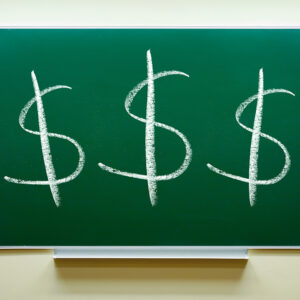Granite State taxpayers have broken the $20,000 barrier on school spending, even as K-12 academic performance remains flat and school enrollment declines.
“Last week, the New Hampshire Department of Education released its newest cost per pupil data for the 2022-2023 school year,” the department said in a press release. “The new statewide average operating cost per pupil of $20,323 is a 4.8 percent increase from last year’s average cost per pupil of $19,400. Total expenditures for the 2022-2023 school year were more than $3.8 billion in New Hampshire.”
To put the $20,323 in perspective, tuition to attend Bishop Guertin High School, a highly-ranked private Catholic school in Nashua, is $16,400. Mount Royal Academy is the highest-ranked Catholic school in the state. High school tuition is $10,700.
New Hampshire also spends far more per pupil than most of the nation. Across the U.S., the average cost per pupil is shy of $14,295, putting New Hampshire in the top 10 nationally for education spending. And as state Education Commissioner Frank Edelblut told NHJournal, taxpayer spending on public schools has been soaring for more than a decade.
“The statewide average for New Hampshire’s cost per pupil has increased by nearly 87 percent since 2000 when it cost less than $11,000 per student. During this same time frame, public school enrollment has dropped by about 20 percent statewide,” Edelblut said.
According to Edelblut, student enrollment numbers in the Granite State have dropped from 207,684 in 2002 to 165,095 in 2023. That’s a decrease of 42,589 public school students, or about a 20.5 percent decline during the past 21 years.
Despite the massive increase in spending, Granite State students are struggling on achievement tests like the SAT. House Education Committee vice chair Rep. Glenn Cordelli (R-Tuftonboro) said it’s time to pay attention to the poor return on investment.
“It’s pretty evident that over probably a couple of decades, spending is going up, and achievement scores are pretty much flat,” Cordelli said.
New Hampshire’s 2023 SAT scores dropped off slightly again. The junior class scored 35 percent proficient in math compared to 37 percent in 2022 and 42 percent in 2021. Students also lost ground on reading proficiency in 2023, with 60 percent proficiency compared to 61 percent proficiency in 2022 and 63 percent proficiency in 2021.
Edelblut said the increasing cost per pupil is partly due to increasing costs, and partly due to the steady drop in the number of students.
“While we have and will continue to work to expand resources for all students, it is clear that we are in a challenging environment of escalating costs and decreasing student enrollment,” Edelblut said.
Some school districts manage to come in under the new average, with Manchester at $16,636, Nashua spending $18,107, and Bedford at $17,418. Concord is spending $22,190 per pupil, and New Hampshire’s highest cost per pupil is New Castle at $41,754, a little more than the $41,650 tuition at The Derryfield School, an exclusive private day school in Manchester.
The record spending for public school students comes as the legislature is being pressed to find a way to change the way public education is funded. New Hampshire relies largely on local property taxes to fund public education, with the state sending an adequacy grant to districts that average $4,100 per pupil.
The district responsible for New Hampshire’s current school funding scheme thanks to lawsuits in the 1980s and 1990s, Claremont, is spending almost $22,000 per pupil. The Contoocook Valley Regional School District, behind a lawsuit that could change New Hampshire’s funding system again, is spending more than $25,000 per pupil.
The recent decision in the ConVal lawsuit has the state under court order to increase the adequacy aid grant to at least $7,300. Cordelli said that increase puts New Hampshire on the path to an income tax. The ConVal decision is stayed as the state appeals to the New Hampshire Supreme Court, giving the legislature time to find another funding plan.
Parents and homeowners frustrated with high property taxes and poor achievement are going to demand changes, Cordelli said.
“At some point, the public is going to become aware, and something is going to happen,” Cordelli said.
Parents are already finding lower cost, and sometimes better quality, opportunities outside the public school system. Kate Baker Demers, executive director of Children’s Scholarship Fund New Hampshire, said the average Education Freedom Account grant in New Hampshire is $5,255, about a quarter of the new cost per pupil for public school students.
“So, if a parent taxpayer is concerned about the high spending and cost, they could choose an EFA and save the state $14,745 per child. Which is, what, the amount that other states spend in total?” Baker Demers said.
This school year, EFA enrollment went up 20 percent to 4,211 students in New Hampshire. Of that total, 1,577 are new to the program. Taxpayers are now paying a little more than $22 million for EFA grants.



